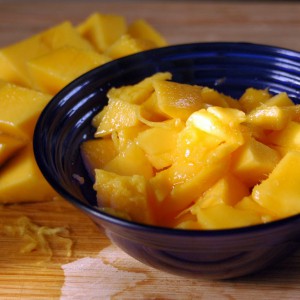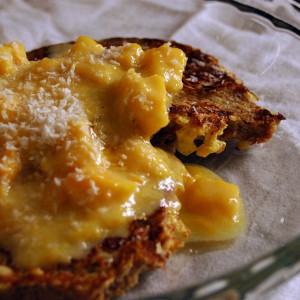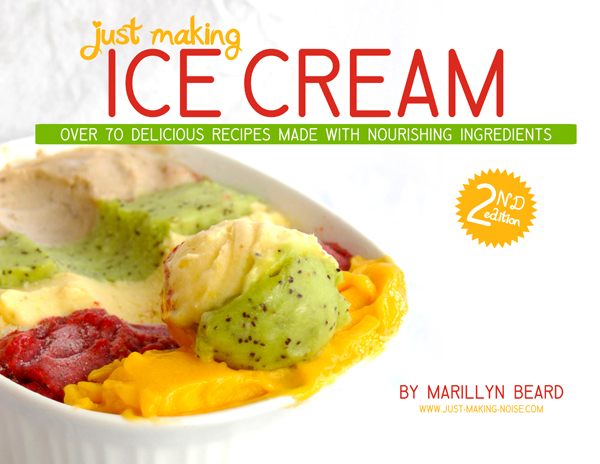
Mangos…hmmm…explodes with flavor and sweetness! I love the smaller varieties because they are less fibrous and have a great soft, juicy flavor. I started writing this post over a month ago, but never got around to finish it. Now I have and I hope you will enjoy what I’ve learned so far about mangos. Okay, I’m going to go have one right now while I am thinking and drooling about it :o)
So, most of you probably know the saying…“One apple a day will keep the doctor away!” Now I can change that to “One mango a day will keep the doctor away!” Keep reading and you’ll find out why.
There are many health and nutritional benefits from eating mangoes. I eat at least one a day with my smoothies, fruit salad or even as a simple dessert! Mangos are very popular here in Costa Rica (how can it not be?!) and also known has the “the peach of the tropics”.
Comforting Health Benefits
In India mangoes are used as blood builders. Because of their high iron content they are suggested for treatment of anemia and are beneficial to women during pregnancy and menstruation. People who suffer from muscle cramps, stress, and heart problems can benefit from the high potassium and magnesium content that also helps those with acidosis.
Doing my research on mangos, I found this claim from different websites: “One lab test turned up rather amazing results that raised mangoes to the “highest perch”. Mango juice was poured into a test tube that contained viruses. Shortly, the viruses were destroyed.” I googled all over, but I wasn’t able to fully confirm that. So, If you know where the report is for that lab test or able to confirm that it is true… please let me know!
- Mango, being high in calories and carbohydrates, is good for those who are trying to gain weight.
- The phenolic compound found in mangoes has been found to have powerful antioxidant and anticancer properties.
- Being high in iron, mango is said to be very good for pregnant women as well as for people suffering from anemia.
- Mango is believed to be effective in relieving clogged pores of the skin.
- The vitamin A (beta-carotene), vitamin E and selenium present in mangoes provide protection against heart disease.
- Mangoes have been found to be quite helpful in treating acidity and poor digestion.
- It is being said that the Vitamin E present in mango helps hormonal system function more efficiently and thus, boosts sex life.
- The anti-inflammatory properties of mango might help alleviate asthma symptoms.
Other BenefitsMango has been found to be beneficial for people suffering from the following ailments:
- Bacterial Infections
- Constipation
- Diarrhea
- Dysentery
- Eye Disorders
- Hair Loss
- Heat Stroke
- Leucorrhea
- Liver Disorders
- Menstrual Disorders
- Morning Sickness
- Piles
- Prickly Heat
- Scurvy
- Sinusitis
- Spleen Enlargement
- Vaginitis
Being of the plant kingdom, mangos contain only about .6 grams of total fat. Their sodium content ranks low at 4 mg.
Mango is at the top in the beta carotene realm, summing up at 8061 IU for that same medium size. If you’re looking for a boost in potassium, look no further than a medium mango with its 322.92 mg. It is the perfect fruit to replenish energy after heavy physical exercise like jogging or working out. The magnesium content is 18.63 mg with traces of manganese, selenium, sodium and phosphorus.
Mango scores 57.3 mg of vitamin C and offers impressive numbers for vitamins B1, B2, B3, and B6. There’s even a touch of zinc in the fruit with calcium at 20.7 mg. and iron at .27 mg.
Although these figures will vary with the different varieties and different sizes, there is little doubt that the mango is an amazing fruit. Not only for its high-ranking nutrients, but also for its intense, juicy and delicious flavor that really taste like paradise itself. (Veg For Life)
History
Sometimes the mango has been described as a combination of a peach, pineapple and apricot. Whatever you believe the taste to be, eating the velvety and fresh juicy mango is an unforgettable experience. It is said that there are over 1,000 varieties of mangos throughout the world. Wow! How can that be?
A native of Southwest Asia, the mango has been cultivated and praised since ancient times. The Persians are said to have brought the fruit to East Africa in the 10th century. In the 16th century, the mango was introduced to Brazil and the West Indies… and the rest is history!
Mangos normally reach maturity 4-5 months after flowering. The yield usually varies with the age of the tree. At 10-20 years, a good crop may be 200 or more fruits per tree. Washing the fruit after harvest is not only important to remove poisons, but it will prevent leaking sap from burning the skin and making black lesions, which leads to rotting. To choose a good mango, make sure is has a floral scent and it should give slightly to the touch if it is ripe.
How The World Eats Their Mangos
Mangoes lend their tangy sweet flesh to many inventive dishes, especially in Indian and Southeast Asian cuisine. During times of famine in India, even the mango seed was eaten after lengthy boiling. In India mangoes are dried, ground into a powder, and used in amchur, a condiment similar to chutney. Jamaicans also dry their mangoes to make a spicy condiment similar to chutney.
India may have been the original inventor of sweet and chewy fruit leathers, which, centuries ago, they began making from ripe mangos. They’re also noted for their mango pickle that can be quite fiery hot and spicy. Indian restaurants today typically feature a beverage called Lassi made with mango, yogurt, sugar, ice and a touch of ground cardamom.
Mango chutney, an Indian condiment made from green mango, brown sugar, vinegar, hot peppers, and ginger is probably the most well known dish that employs the mango.
In their unripe form, mangos are just as appealing as when fully ripe. Throughout Southeast Asia, green mango salads are common and take on a variety of seasonings that incorporate lime juice, chiles, and rice vinegar. In the Philippines, unripe mangos are enjoyed as a between-meal snack sprinkled with salt or dipped into soy sauce.
In Guadalupe, a city in the central region of Mexico, mangos are chopped, salted and sprinkled with a little oil and served as a refreshing appetizer.
Here in Costa Rica, everybody loves to eat ripe mangos as it is or in smoothies (with water or milk). With green mangos, they sprinkle lime and salt for a quick, refreshing snack.
The Many Ways To Enjoy A Mango
There are many ways to enjoy your mango. You can simply peel back the skin and eat the entire mango like a banana. It’s rather a messy adventure and mango juice can leave a permanent stain on clothes, so have lots of napkins and towels on hand.
Mangos can be sliced, diced, and julienned into fruit salads. They also make a fun, tangy addition to tossed green salads.
Pureed in the blender, mangoes add delectable sweetness to smoothies and creamy sauces over fruit salads.
Enjoy fresh mango salsa with diced mango, onions, tomatoes, garlic, cilantro, lime juice, sea salt, and sweet or hot peppers.
Raw soups enjoy a boost in nutrition and a lively flavor lift with the addition of fresh mangoes
Try diced mangos on your oatmeal and use them as a dramatic garnish over grain or legume dishes.
Sorbets are a refreshing way to incorporate mangos into your summer menus.
Mangos are also delicious served over grilled chicken or fish. I’ve made a roast with mangos and was thrilled with how yummy it was.
It is often a struggle to remove the seed from the mango. The flesh does not leave the large central pit very well. It is best to cut on either side of the mango pit. This is the popular way to cut up your mangoes. Its almost like cutting an avocado, pretty easy. A few gals ask me to demonstrate on video how I cut a mango. So, I had my mom film me with our cool flip camera, but I am having trouble uploading the video! I gave up… but you can google “how to cut a mango” and you’ll get good videos.






Thanks for this very useful lesson about Mango. I will definitely eat more Mango from now
Great information on mangos! Cutting one can be an adventure, so I’m glad to hear there are some videos out there that I can watch.
Hello ,
The informative Article on Juicy Mangos: The Peach Of The Tropics is amazing.It give detail information along with awesome picture. Thanks for Sharing the information about it